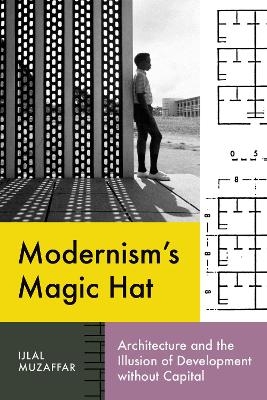
Modernism’s Magic Hat
University of Texas Press (Verlag)
978-1-4773-2966-5 (ISBN)
- Titel z.Zt. nicht lieferbar
- Versandkostenfrei innerhalb Deutschlands
- Auch auf Rechnung
- Verfügbarkeit in der Filiale vor Ort prüfen
- Artikel merken
In Modernism’s Magic Hat, Ijlal Muzaffar examines how modern architects and planners help resolve one of the central dilemmas of the mid-twentieth-century world order: how to make decolonization plausible without accounting for centuries of capital drain under colonial rule. In the years after World War II, architects and planners found extensive opportunities in new international institutions—such as the World Bank, the UN, and the Ford Foundation—and helped shape new models of global intervention that displaced the burden of change onto the inhabitants. Muzaffar argues that architecture in this domain didn’t just symbolically represent power, but formed the material domain through which new modes of power acquired sense. Looking at a series of architectural projects across the world, from housing in Ghana to village planning in Nigeria and urban planning in Venezuela and Pakistan, Muzaffar explores how architects and planners shaped new ideas of time, land, climate, and the decolonizing body, making them appear as sources of untapped value. What resulted, Muzaffar argues, is a widespread belief in spontaneous Third World “development” without capital, which continues to foreclose any global discussion of colonial theft.
Ijlal Muzaffar is a professor of modern architectural history at the Rhode Island School of Design and is the coeditor of Architecture in Development: Systems and the Emergence of the Global South.
Introduction. Soft Bricks, Hard Mortar of Immanence: Thinking through Other Figurations of Architecture in Development
Part I: Risk/Belief
Chapter 1. House without a Core: Capturing Intent in Ghana
Chapter 2. God’s Gamble: Self-Help Architecture and the Housing of Risk
Part II: Borders/Open-Endedness
Chapter 3. Boundary Games: Military Rule, International Experts, and the Aesthetics of Incompletion in Pakistan
Chapter 4. “Settlers Welcome”: Designing the Infinite Present, from Pakistan to the Philippines
Chapter 5 Fuzzy Planning: MIT, Harvard, and the Image of Planning in Venezuela
Part III: Materiality/Depth
Chapter 6. Landing Architecture: Bodies and Land in Transition in the Gold Coast
Chapter 7. Tropics of Shame: Fry, Drew, and the Designing of Depth
Chapter 8. Counting Quality: Locating Patterns of Change, from Geddes to Koolhaas
Acknowledgments
Notes
Index
| Erscheinungsdatum | 04.07.2024 |
|---|---|
| Reihe/Serie | Lateral Exchanges: Architecture, Urban Development, and Transnational Practices |
| Verlagsort | Austin, TX |
| Sprache | englisch |
| Maße | 152 x 229 mm |
| Gewicht | 513 g |
| Themenwelt | Technik ► Architektur |
| ISBN-10 | 1-4773-2966-8 / 1477329668 |
| ISBN-13 | 978-1-4773-2966-5 / 9781477329665 |
| Zustand | Neuware |
| Informationen gemäß Produktsicherheitsverordnung (GPSR) | |
| Haben Sie eine Frage zum Produkt? |
aus dem Bereich


